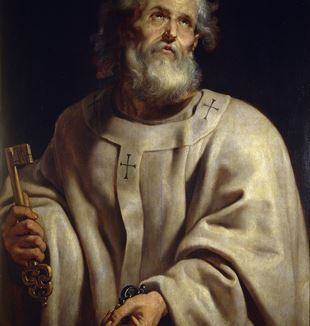
Simon, the Revolutionary who Humbly Followed the Messiah
He belonged to the Zealots, intransigent protesters against the Roman power. Very little is known about him. His relics are venerated beneath the Altar of the Crucifixion in St. Peter'sTo know Simon, one has to begin by knowing his nicknames: the Gospels call him the "Cananean" (in Mark and Matthew) or the "Zealot" (in Luke, as well as in the Acts). For a long time it was thought that Mark and Matthew referred to his origins in Cana in Galilee, the village where Jesus performed his first miracle. Some ancient sources even thought that Simon was the bridegroom at that wedding. Then research into the meaning of his nickname put things back in place. Cananean comes from the Aramaic "qen'ana'," which means zealous, or maybe Zealot. Here, then, the three synoptic Gospels agree about the figure of Simon; he was a zealous apostle with respect to Jewish law and traditions. But some suggest another possibility: couldn't his name mean that Simon belonged to the Zealots?
Josephus Flavius, the Jewish historian who lived at the end of the first century, speaks extensively of this group. He says that they were proponents of a fourth philosophy, after the three of the Essenes, the Sadducees, and the Pharisees. Like these last, the Zealots held a nationalistic-theocratic ideal, but differently from the Pharisees, they were tenacious in the political application of their ideals. They came from an ancient tradition, to the point that Mattathias, father of the Maccabees, had charged his sons to be "the Zealots of the Torah." And in fact, his five sons were all killed on the altar of the nationalist-religious cause.
This intransigence was still alive during Jesus' time. In fact, when the son of Mary was about 13 or 14 years old, Judea was still inflamed by the revolt led by Judas the Galilean against the Roman-imposed census. The revolt was put down, but the fame of Judas the Galilean endured. Also, after the defeat, the Zealots sharpened their tactics and began striking individual targets, armed with a small dagger called a "sica" by the Romans. Thus the Zealots were also called Sicari, and the meaning of Iscariot, Judas's name, derives from the Latin "sicarius."
Jesus was very familiar with intolerance toward the Romans; it was breathed in the air and was a feeling shared also among the disciples. Even Peter was not immune to it, as Antonio Socci recalled in a recent article (Il Giornale, January 15, 2000): "This hypothesis was reached by rereading the fundamental Gospel passage where Jesus appoints Peter: 'Blessed art thou, Simon bar-Yonah. Thou art Peter and upon this rock I will build my Church." For centuries this "bar-Yonah" has been interpreted as a patronymic, translating it as "Simon, son of Jonah." But after Dalman's study of the ancient Hebrew lexicon, many exegetes consider the term a derivative from the Accadian meaning "terrorist," a name well-suited to Peter's fiery temperament and his instinctive recourse to arms in times of danger (at Jesus' arrest)."
A relative of Jesus
Therefore, Simon the Cananean came from this fringe of intransigent protesters against Roman power. But, knowing this, we can take measure of the attraction exercised by Jesus: Simon, like the other probable Zealots, had to swallow first the healing of the Roman centurion's servant in Capernaum and then even the choice of Matthew, the hated tax collector for the Romans, as one of the Twelve.
Simon has another characteristic: Matthew and Mark include him among the brothers of Jesus, along with James the Lesser, the other apostle Judas Thaddeus, and one called Joseph. And along with his brothers is mentioned an undefined group of sisters. How can this be explained? Giuseppe Ricciotti, in his invaluable Vita di Ges˜ Cristo [The life of Jesus Christ], gives a plausible solution: "The designation of this broad group of relatives corresponds well with Eastern custom, where blood ties are pursued also in their distant and tenuous ramifications. Already in the Hebrew Bible the terms 'ah' (brother) and 'ahoth' (sister) designate relatives much more distant than blood brothers and sisters." And in fact, ancient Hebrew has no specific term for cousin. Thus Simon was, in all probability, Jesus' cousin.
Very little is known of him in the following years. He has been identified as Simeon (the same as Simon), he too a brother of Jesus, who took the place of James the Lesser in the leadership of the Church in Jerusalem after 62 A.D., dying a martyr in 107 under Emperor Trajan. The Roman breviary says, instead, that he was in Egypt and Mesopotamia with the other apostle Judas. It is not known, however, where he was buried, although his relics are now venerated under the Altar of the Crucifixion in St. Peter's.